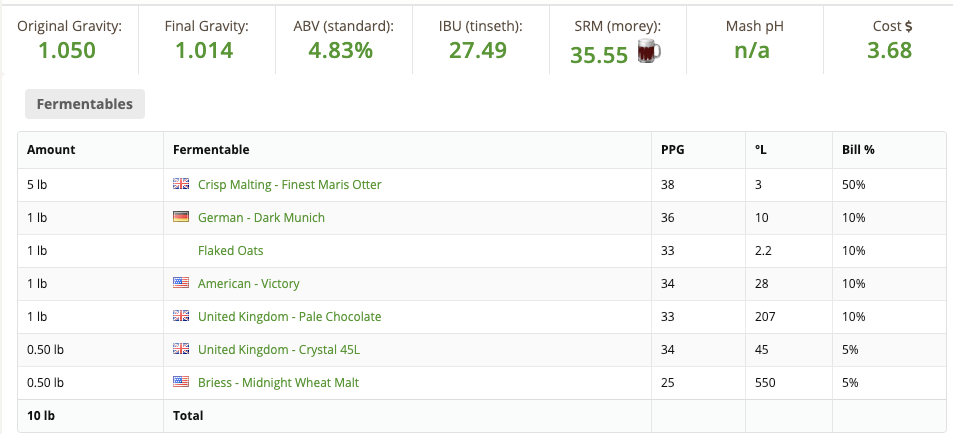luckybeagle
Making sales and brewing ales.
I brewed an Oatmeal Stout with an OG of 1.050 on Monday, mashing at 154F for 60 minutes followed by a 170F mashout. I pitched a 1.3L starter of Wyeast 1318 into well aerated wort and put the carboy into a 66F fermentation chamber. The yeast was fresh--just a week old from Wyeast according to the package's date.
Yesterday I took a hydrometer reading since the airlock stopped bubbling. It came in at 1.019. Tasted fine, albeit young. I then bumped the temperature up to 68F to encourage it to finish. Today, my gravity hasn't budged, though it does taste better, so I tried to rouse the yeast with my wine thief a little. I guess we'll see what this does.
50 - 19 = 31 gravity points chewed through. 31/50 = 62% apparent attenuation. Seems crazy low, even for a hotter mash. I primarily brew Belgians and routinely achieve 80+% attenuation on those styles with step mashes and low temps, so maybe this is par for the course for this yeast and mash temp? Just seems incredibly low--I was expecting a FG of 1.012-1.014 tops. Any thoughts on my process or what might've happened?
FWIW: I'm brewing on a 15 gallon, 3 vessel eHerms system utilizing a recirculating mash and PID temperature control via Auber Cube 2E and 2x5500w elements in my HLT and BK.
Thanks
Yesterday I took a hydrometer reading since the airlock stopped bubbling. It came in at 1.019. Tasted fine, albeit young. I then bumped the temperature up to 68F to encourage it to finish. Today, my gravity hasn't budged, though it does taste better, so I tried to rouse the yeast with my wine thief a little. I guess we'll see what this does.
50 - 19 = 31 gravity points chewed through. 31/50 = 62% apparent attenuation. Seems crazy low, even for a hotter mash. I primarily brew Belgians and routinely achieve 80+% attenuation on those styles with step mashes and low temps, so maybe this is par for the course for this yeast and mash temp? Just seems incredibly low--I was expecting a FG of 1.012-1.014 tops. Any thoughts on my process or what might've happened?
FWIW: I'm brewing on a 15 gallon, 3 vessel eHerms system utilizing a recirculating mash and PID temperature control via Auber Cube 2E and 2x5500w elements in my HLT and BK.
Thanks
Last edited:
















![Craft A Brew - Safale S-04 Dry Yeast - Fermentis - English Ale Dry Yeast - For English and American Ales and Hard Apple Ciders - Ingredients for Home Brewing - Beer Making Supplies - [1 Pack]](https://m.media-amazon.com/images/I/41fVGNh6JfL._SL500_.jpg)











































